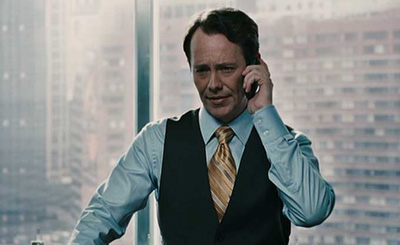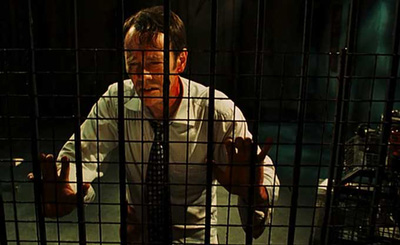William Easton is a fictional insurance claims investigator, and in this post I’m going to advocate for him. This is Easton:

And okay, I grant you, this is the douchiest-looking dude on the planet. Nobody is disputing that fact. Before you condemn him, though, consider that this is also Easton:

See, William Easton is Jigsaw’s primary victim in Saw VI. Previous victims included people like apathetic doctors, heroin addicts, loan sharks, murderers and cops more preoccupied with dead criminals than live victims. Now, don’t get me wrong. None of these people deserved to be put in hopeless situations where self-mutilation was the only egress. In the context of a fictional slasher-movie universe, though, you can almost appreciate Jigsaw’s sense of karmic justice. Bad things happening to bad people, and all that.
I’m not saying “William Easton didn’t deserve it” in that context, though. The reason he didn’t deserve it wasn’t because no human deserves to be tortured; it’s because he wasn’t guilty of the crimes Jigsaw was punishing him for.
Easton was the head of Jigsaw’s insurance company. It was his job to approve or deny claims, including Jigsaw’s. It’s easy for modern American society to automatically demonize someone with this job, much in the same way that lawyers are bloodsuckers, politicians are liars and cops are all bacon. I mean, that’s the beauty of Easton’s character. Five sequels deep in an established horror series is not the time to innovate. Only a few characters in this series have survived long enough to develop any kind of personality, and inventing a new one is too hard. But they needed a new victim, and a white collar worker from an industry everyone already instinctively hates was ripe for picking.
Problem is, they forgot to make Easton an actual loathsome figure. He’s in the trap because of his job, full stop.
First and foremost, let’s understand just how hard of a job Easton has. His company doesn’t have enough money to save everyone; that’s just the ugly truth of the American insurance industry. He has to save some people, of course, or his company’s reputation would be flushed and there would be no profit. Undoubtedly, though, there are people trying to cheat his company with frivolous claims, and people who aren’t trying to cheat but neither can actually be saved. Both of these types of people need to be denied coverage so there’s enough money left for everyone else.
That’s Easton’s perspective, anyway. Whether or not you agree with that could spark an interesting discussion the state of modern health care, which is kind of outside the scope of a blog post about Saw VI, so we’ll leave well enough alone.
Jigsaw’s beef with Easton is that Easton developed the profit-maximizing formula by which claims are evaluated. Which means, yes, Easton’s job was to decide which people received coverage and which didn’t. Or as Jigsaw put it to him, “who lives and who dies”. That’s a pretty heavy responsibility, and no doubt there have been people in Easton’s position in reality that have squandered it or otherwise approached it irresponsibly. As terrible as it is to have to stamp someone’s claim denied, though, we are never shown any evidence that Easton is at all corrupt, apathetic or otherwise ill-intentioned.
We get to see two instances of Easton denying someone coverage, and both times it’s done face-to-face. The first is a man with cancer whose claim was denied because he failed to list a pre-existing condition on his application. The second was Jigsaw himself, who wanted to use Easton’s company’s money to go outside the system and seek unproven, experimental treatment not approved by his doctor. What’s interesting about this is not the conversations Easton has with his clients, but that he’s having conversations with them at all. That shows, to me, that he absolutely takes his clients seriously, and is open to rational discussion with them.
In his conversation with Jigsaw, he most definitely is the rational one. Jigsaw pitches a new type of cancer treatment involving gene therapy, for which his doctor believes he is not a candidate. Based on the doctor’s rationale, Easton has to deny his claim. Jigsaw is the one who starts in with the cursing, the threats, and the loaded language. He blames his doctor for not caring enough about his patients; likely true, but not Easton’s fault. (And besides, the doc got his way back in Saw I.) He goes off on a tirade about insurance companies in general, none of which Easton can really respond to. He even claims it’s not about the money. He says he has money. Money’s not the issue here.
If money’s not an issue for Jigsaw, why did he sign a contract with Easton’s company to begin with?
The bottom line is that Jigsaw seeks to punish Easton for crimes committed by the entire industry he works for. This strikes me to be every bit as impersonal and apathetic as many of Jigsaw’s other victims are towards the people they hurt.
Throughout his trials, Easton is forced again and again to decide who in the traps will live and who will die. The perfectly healthy 20-something with no family? Or the smoker in her 50s with a full and loving family? Not surprisingly, when the people in question are his colleagues and not his clients, and his decisions have no bearing on his professional ethics, Easton chooses to let the “less viable” people live. Decisions which, if made on a large scale, would ruin his company and leave the entire industry bankrupt. Jigsaw tries to introduce the element of personal involvement into an equation that has to be designed without that element, or it doesn’t work.
At one point Easton is holding a chain in each hand, his arms stretched near to breaking, the lives of two people he works with laying in the balance. He cries out, “This isn’t how I make my decisions!” It’s hard not to be sympathetic.
That’s my defense of William Easton. Jigsaw doesn’t lock him up because he’s a criminal or because he’s hurting people… but because he has a grudge against the insurance industry. It’s interesting to watch a Saw movie and constantly be siding with the guy in the trap. You’re not supposed to side with the guy in the trap, you know. Especially not the dirtbag insurance guy.
But thanks to the short-sightedness of Saw VI‘s writers, who expect you to automatically equate insurance companies with dark-centered evil, you can sympathize with poor ol’ Easton. Poor Easton who, in the end, dies the most horrific death the series has to offer despite having apparently learned all the lessons Jigsaw wanted him to learn. Bum rap, brother. It’s not your fault you look like such a douchebag.
I kind of get what you’re saying here but didn’t they make it out to be that William Easton is the person who worked out the formula to ascertain who can be covered and who cannot? It is kinda weak, but I guess they had to make something up.
Still love a good ol’ hydrochloric-acid into-the-guts spike though!
I have an idea for a future saw film imagine if Pamala kidnaps Brent and puts him in a saw trap as revenge for killing her brother